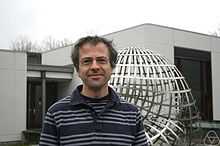Gábor Tardos
| Gábor Tardos | |
|---|---|
 | |
| Born |
11 July 1964 Budapest |
| Nationality | Hungarian |
| Fields | Mathematics |
| Institutions | Simon Fraser University |
| Alma mater | Hungarian Academy of Sciences |
| Doctoral advisor | László Babai |
| Notable awards |
Erdős Prize (2000) EMS Prize (1992) |
Gábor Tardos (born 11 July 1964) is a Hungarian mathematician, currently a professor and Canada Research Chair at Simon Fraser University. He works mainly in combinatorics and computer science. He is the younger brother of Éva Tardos.[1]
Mathematical results
Tardos started with a result in universal algebra: he exhibited a maximal clone of monotone operations which is not finitely generated. He obtained partial results concerning the Hanna Neumann conjecture. With his student, Adam Marcus, he proved a combinatorial conjecture of Zoltán Füredi and Péter Hajnal which was known to imply the Stanley–Wilf conjecture. With topological methods he proved that if  is a finite set system consisting of the unions of intervals on two disjoint lines, then
is a finite set system consisting of the unions of intervals on two disjoint lines, then  holds, where
holds, where  is the least number of points covering all elements of
is the least number of points covering all elements of  and
and  is the size of the largest disjoint subsystem of
is the size of the largest disjoint subsystem of  . Tardos worked out a method for optimal probabilistic fingerprint codes. Although the mathematical content is hard, the algorithm is easy to implement.
. Tardos worked out a method for optimal probabilistic fingerprint codes. Although the mathematical content is hard, the algorithm is easy to implement.
Awards
He received the European Mathematical Society prize for young researchers at the European Congress of Mathematics in 1992 and the Erdős Prize from the Hungarian Academy of Sciences in 2000. He received a Lendület Grant from the Hungarian Academy of Sciences (2009).[2] specifically devised to keep outstanding researchers in Hungary.
Selected publications
- ——— (2008), "Optimal probabilistic fingerprint codes", Journal of the ACM 55, doi:10.1145/780542.780561.
- ——— (1995), "Transversals of 2-intervals, a topological approach", Combinatorica 15: 123–134.
- ———; Ben-David, S.; Borodin, A.; Karp, R.; Wigderson, A. (1994), "On the power of randomization in on-line algorithms", Algorithmica 11: 2–14.
- ——— (1986), "A maximal clone of monotone operations which is not finitely generated", Order 3: 211–218.
References
- ↑ Baseball Families and Math Families, William Gasarch, February 12, 2009.
- ↑ Lendületben az MTA
External links
|